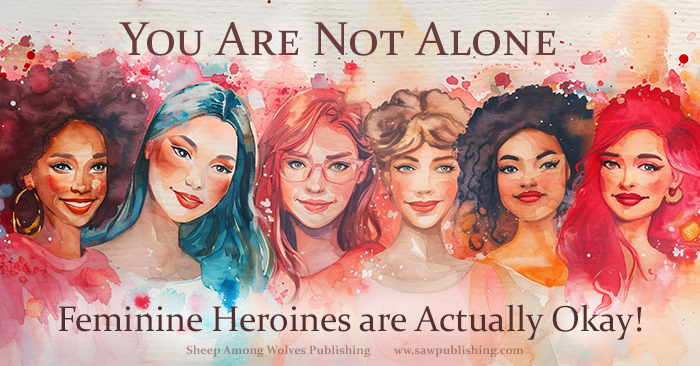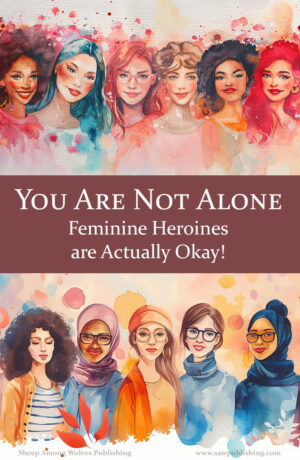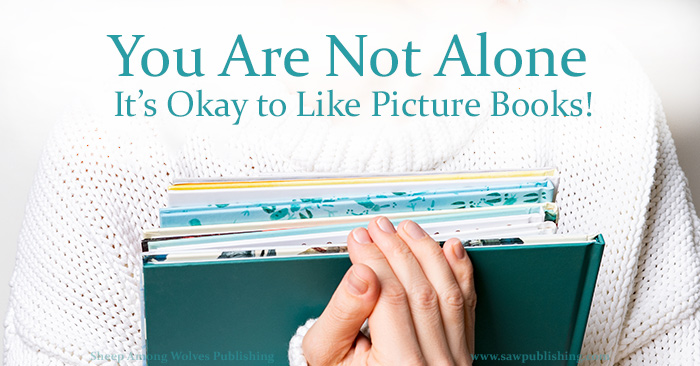You Are Not Alone: Feminine Heroines are Actually Okay!
 As far as I’m concerned, Anne of Green Gables belongs in the spring.
As far as I’m concerned, Anne of Green Gables belongs in the spring.
I’m totally fine if you disagree with me on that one. It’d be hard to find a fictional character who has a greater appreciation for ALL the seasons than Anne does. If Lucy Maud Montgomery’s beloved heroine belongs on a warm summer morning with a glass of ice tea—or on a crisp fall afternoon with brilliant leaves floating outside your window—or on a cozy winter night, curled up in front of a glowing fire—I’m not going to quarrel with your taste in the slightest.
But for me, Anne of Green Gables means springtime.
It means misty green on a far-off treeline. It means windows standing open to let in sweet-smelling air. It means pretty, frilly, flower-trimmed ideas.
It means something remarkably feminine.
And Now We’ve Hit the “I’m All Alone” Moment
 Because I think I just called one of your favourite characters a remarkably feminine heroine.
Because I think I just called one of your favourite characters a remarkably feminine heroine.
Which is an idea that—oddly enough—doesn’t fit very well into our literary box.
We’ve been well conditioned to the tomboy heroine. Not necessarily just the running-wild, wearing-overalls-in-the-‘40’s, wants-to-make-her-brother’s-sports-team kind of tomboy.
(Please note, I’m not necessarily trying to make a political statement about either 1940’s overalls or girls’ sports teams here. But sometimes stereotypes let you condense a 300-page-novel into a couple of sentences for the convenience of analysis.)
What remains true is that we have come to accept the standard heroine as a girl who is less than secure with the idea of being a girl in the first place.
“I Can Do It Myself!”
Admittedly, it makes a good setup.
Weirdly enough, makes just as good a setup for the heroine who’s going to end up falling in love with an entirely masculine man and living happily-ever-after like a genuine fairytale princess, as it does for an author who is consciously attempting to overthrow a prototype with her writing.
Simply because “I can do this myself!” makes a good story.
It gives us some instant conflict.
It raises immediate and future questions in our minds.
And as our heroine fights to be her genuine self—in the midst of a world that expects her to either surrender to social pressures and lose her individuality, or else disregard social expectations and end up more or less of an outcast—our human sympathies for the underdog are securely engaged, and we all breath a sigh of relief when we get to the end of the story, and discover that after all, our tomboy heroine was able to find her true identity and still find love, acceptance, and value along the way.
It works.
It makes a compelling story.
The internal and external conflict combined make a compelling heroine.
But Does She Have to be the Only Heroine in Fiction?
Because while I may be alone in this totally un-trendy viewpoint—I kind of suspect I may not be.
I kind of suspect some of you may enjoy the all-out feminine heroine as well.
And by feminine here I am not talking about a personality trait.
To return to our heroine from the beginning of this post—it would be hard to imagine a character with a more overflowing extraverted personality than Anne of Green Gables. Anne loves to be talking, and laughing, and running outdoors, and defying social expectations, and doing everything which the stereotypical cardboard girl character isn’t supposed to do.
I think I’d even go so far as to say that both Anne and her author have a touch of the feminist in their worldview.
And yet, Anne is the heroine who can’t live without puffed sleeves. The heroine who unashamedly declares “I’d rather be pretty than clever.” The heroine whom Lucy Maud Montgomery describes as “feminine to the core.”
Feminine Heroines are Actually Okay!
As a matter of fact, they’re more than okay.
They have something valuable and much-needed to contribute to our era of literature.
I’d love to dive deeper into some structural analysis of exactly what feminine heroines have to contribute to fiction. Because the tomboy heroine trope isn’t the only one that brings uniquely valuable dynamics to the table in a story world.
Maybe that will be another post for another day.
But right now I want to remind you that there’s nothing wrong with loving girls who love to be girls! There’s nothing wrong with loving a feminine heroine.
Anne of Green Gables and I are both here to tell you—you’re not alone!
You might also enjoy:

